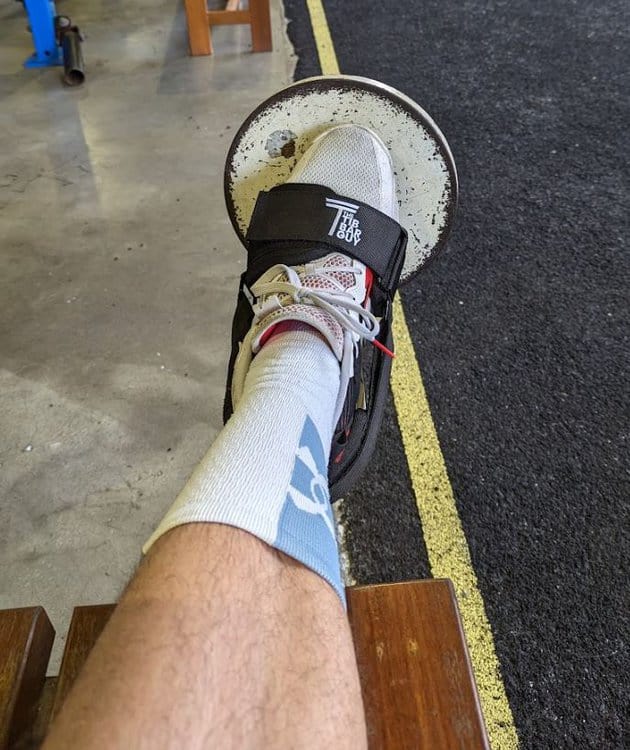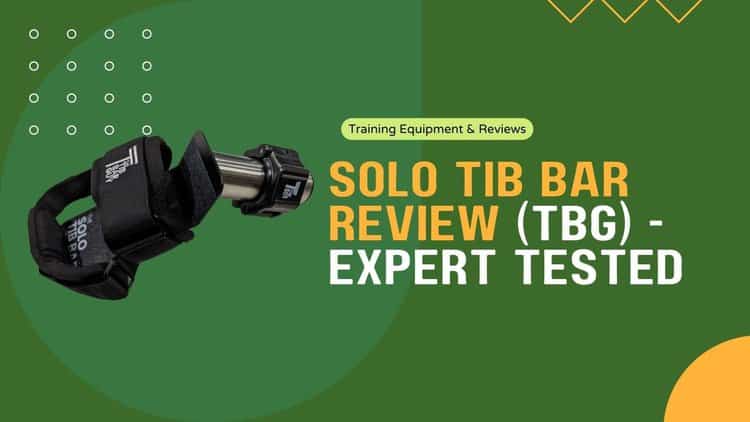Solo Tib Bar Review Summary
Solo Tib Bar
When it comes to single leg tib bars, it doesn’t get much better than the Solo Tib Bar from The Tib Bar Guy.
Having personally tested every single leg tib bar on the market, I can confirm that the Solo Tib Bar performs really well overall.
4
The Good
The best way to train peroneals and tib posterior (ankle inversion/eversion).
Unilateral training irons out muscle imbalances.
Best option for rehabbing injuries or regaining strength after surgeries.
Very comfortable and easier to use than the Isotib.
Significantly more affordable than the HGG Isotib.
The Bad
I honestly can’t think of anything I don’t like about the Solo Tib Bar!
Recommended Use
The Solo Tib Bar is ideal for anyone who wants to work all of the lower leg muscles, not just the tibialis. It’s also great for injury/surgery recovery.
Make sure to use my discount code “A1ATHLETE” for 10% off your entire order!
Solo Tib Bar Full Performance Review
It’s pretty rare that I rate a product 5/5 stars but the latest Solo Tib Bar just checked every box for me…

TBG have improved the Solo Tib Bar by adding a heel strap for better lockdown and they’ve also added a weight clamp you can attach for when you want to move heavier weight.
Super Quick & Easy To Use
The Solo Tib Bar is still quite easy to get into/out of and is super enjoyable to use.
It’s actually significantly quicker and easier to secure the Solo Tib Bar to your foot than it is to secure the HGG Isotib to your foot, which takes 10+ seconds to adjust the foot clamp each time you put your foot in!
This is one of the major reasons I prefer using the Solo Tib bar over the Isotib.
Great Build Quality
The Solo Tib Bar is really well put together. The metal foot plate is super solid and the heavy duty strap works extremely well.
The TBG weight clips are also the best I’ve ever seen and do an excellent job at preventing weight from sliding around on the weight sleeve.
The Solo Tib Bar Is The Best Way To Strengthen Crucial Lower Leg Muscles
Regular tib bars can really only train the muscles involved in ankle dorsiflexion (primarily the tib ant).
While that’s useful, it’s not a comprehensive lower leg workout.
In addition to the tibialis anterior, the Solo Tib Bar is able to develop the tibialis posterior, peroneals, hallucis muscles, and FDL.
These are the muscles primarily responsible for ankle inversion and eversion.

The Solo Tib Bar is able to target these muscles in one of two ways: rotations or lateral raises.
Solo Tib Bar Rotations
Instead of dorsiflexing your ankle, simply rotate your foot around in a circular motion.
*Clips below are of me using the old version, but it works just the same with the latest one.
This is the simplest way to hit all of the muscles involved in eversion/inversion. Make sure to move in both directions.
Solo Tib Bar Inversion Raises
If you wanted to be more deliberate, you can tilt your leg so that your outer lower leg is supported, allowing you to perform inversion raises to target your tibialis posterior, FDL, and hallucis muscles.
Solo Tib Bar Eversion Raises
If you internally rotate your leg, you can perform eversion raises using the Solo Tib Bar which will focus more on your peroneals.
Ankle Inversion/Eversion Ability Is A Game Changer For Athletes
Why is any of this important?
Going out of your way to deliberately train the muscles responsible for inversion/eversion isn’t just another way to bulletproof both your ankles and knees, but it can give you a serious competitive advantage…
Your Invertor/Evertor Muscles Are Central To The Vertical Jump
Let’s take a look at how fundamental this inversion/eversion movement is in the vertical jump.
As the athlete in the above clip punches his block foot out in front of himself horizontally, there is a tremendous amount of force being transferred through the lower legs.
There’s actually large amounts of inversion/eversion occurring in both ankles during the jump approach.
There’s also some natural coiling of the lower legs which helps us explosively transfer force from our feet through to our knees.
Really strong invertor and evertor muscles are going to help us be as stable as possible throughout the jumping motion, which means improved efficiency (i.e. leaking less potential energy), which results in more force output.
The Solo Tib Bar Can Improve Balance Massively
One of the other major benefits of actually training inversion/eversion with a Solo Tib Bar is hugely improved balance.
If you stand on one leg and look down at your ankle, you’ll see lots of tiny movements at the ankle joint as you try to balance.
Balancing on one foot is nothing more than tons of really quick micro-corrections being produced primarily through your invertor/evertors (coronal plane) as well your dorsi/plantar flexors (sagittal plane).
Building these muscles up is one of the quickest ways to improve your balance which is beneficial for a whole host of athletic pursuits.
How I Tested The Solo Tib Bar
Over the last few weeks I’ve been using my Solo Tib Bar every other day, typically doing about 6 sets per leg, per day.

I do a mixture of rotations as well as regular tib raises to ensure both my tibs and invertor/evertor muscles are getting a complete workout.
I tested the Solo Tib Bar using a variety of different weight plates and had absolutely no issues with plates fitting on the sleeve.
How Did The Solo Tib Bar Feel To Use?
Having used both the HGG Isotib as well as the Solo Tib Bar, I can pretty confidently say that the Solo Tib Bar is much nicer to use overall.
It’s smaller and requires a lot less fiddling around to use.
I found that I was able to secure the device to my foot far more easily and quickly using the Solo Tib Bar, especially with the new ankle strap.
The Solo Tib Bar Works Great Barefoot!
I also had absolutely no issues using the Solo Tib Bar barefoot!
Sleeve Detaches For Increased Portability
Although the Solo Tib Bar is already pretty small (compared to the Isotib), it also has a detachable weight sleeve which makes it even more compact.

Because of the flat foot plate, it’s also much easier to throw the Solo Tib Bar into your gym bag than it is the bulkier Isotib!
Doesn’t Take Too Long To Train Both Legs
One of my initial hesitations about single leg tib bars is that you’d end up spending twice as long to train your tibialis anterior, since you’d only be able to train one leg at a time…
But this didn’t really end up being the case.
If you’ve ever done a brutal set til failure using a regular tib bar, then you’ll know you’re going to need at least a couple minutes to recover before beginning your next set.
When I’m using my regular tib bar, I usually just walk around and try to get some active recovery in…
But when you’re using the Solo Tib Bar, you can train your second leg while your first leg is recovering, so it’s not actually taking anywhere near twice as long to get through your tib workout!
Tib Bar Pro Vs Solo Tib Bar
So which is better?

Sometimes I just want to get a quick and easy tib workout in and I’ll just throw my TBG Tib Bar Pro in my bag and head to the gym.
When I’m in the mood to completely annihilate my lower legs, I’ll tend to grab the Solo Tib Bar so I can get the most comprehensive workout possible.
Unilateral Tib Training Is More Thorough
One thing you can’t overlook is the importance of unilateral training (training one leg at a time). This reveals and remedies any muscle imbalances you might have.
Just like with squats, when you use a regular tib bar, you’re probably going to heavily favor one leg which is something I definitely noticed – it can be quite hard knowing whether both legs are working as hard as each other.
So, gun to my head, I’d recommend most people go for the Solo Tib Bar because it’s going to train all of the muscles in your lower legs (not just your tibs), as well as iron out any muscle imbalances you might have.
The Solo Tib Bar Now Has A Weight Clamp For Heavier Lifts
The latest addition of the Solo Tib Bar has seen the addition of a weight clamp, which attaches to the weight sleeve, that allows you to pick up dumbbells with your feet.

Clearly inspired by the MonkeyFeet, this new feature allows you to load the bar up with more weight than you can using just the sleeve.
So not only can you train your tibs with this thing, but you can now do leg curls, hip flexor knee raises, and leg extensions!
Some Small Critiques About The Dumbbell Clamp
When using this thing for leg curls, as you can see in the above clip, since the weight sleeve is still attached, you’re kind of banging the sleeve on the floor at the bottom of the rep (just before finishing the rep actually).
This is a very minor thing, but makes the device a little clunky for leg curls compared to something like the Tri-Flexor or even the MonkeyFeet.
The Solo Tib Bar is also really hard to walk around in, the hardest of the 3 – again because of the position of the weight sleeve.
I’m also not sure if there’s much need for the dumbbell clamp to be completely honest – you can load up the weight sleeve with a good chunk of weight to begin with that I can’t imagine too many people having issues with running out of sleeve space.
Sure it makes sense if you’re trying to do really heavy leg extensions, but that’s not really what this type of product is for.
What’s The Verdict?
Overall I’m a fan of the Solo Tib Bar and think the improvements they’ve made are decent.
It’s definitely one of the most comfortable ways to do single leg tib raises.
Yes, it’s a little expensive, but it’s extremely well built and the right athlete will get tons of use out of it.
USE DISCOUNT CODE “A1ATHLETE” FOR 10% OFF YOUR SOLO TIB BAR!


